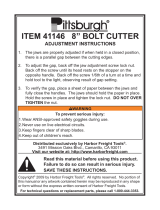
Important Safety Instructions
READ ALL INSTRUCTIONS AND WARNINGS BEFORE USING THIS TOOL.
Operator
COMMON SENSE AND CAUTION ARE FACTORS WHICH CANNOT BE BUILT INTO
ANY PRODUCT. THESE FACTORS MUST BE SUPPLIED BY THE OPERATOR. PLEASE
REMEMBER:
1. When using electric tools, machines or
equipment, basic safety precautions should
always be followed to reduce the risk of fire,
electric shock, and personal injury.
2. Keep work area clean. Cluttered areas
invite injuries.
3. Consider work area conditions. Do not
use machines or power tools in damp, wet,
or poorly lit locations. Do not expose
equipment to rain. Keep work area well lit.
Do not use tools in the presence of flam-
mable gases or liquids.
4. Keep children away. All children should
be kept away from the work area.
5. Guard against electric shock. Prevent
body contact with grounded surfaces such as
pipes, radiators, ranges, and refriderator
enclosures.
6. Stay alert. Never operate equipment if
you are tired.
7. Do not operate the product if under the
influence of alcohol or drugs. Read warning
labels on prescriptions to determine if your
judgment or reflexes might be impaired.
8. Do not wear loose clothing or jewelry as
they can be caught in moving parts.
9. Wear restrictive hair covering to contain
long hair.
10. Use eye and ear protection. Always
wear:
-ANSI approved chemical splash goggles
when working with chemicals.
-ANSI approved impact safety goggles at
other times.
-ANSI approved dust mask or respirator
when working around metal, wood, and
chemical dusts and mists.
-A full face shield if you are producing metal
or wood filings.
11. Keep proper footing and balance at all
times.
12. Do not reach over or across running
machines.
13. Always check that adjusting keys and
wrenches are removed from the tool or
machine work surface before plugging it in.
14. Do not carry any tool with your finger on
either the start button or trigger.
15. When servicing, use only identical re-
placement parts.
Before Operation
1. Be sure the switch is OFF when not in use
and before plugging in.
2. Do not attempt to use inappropriate
attachments in an attempt to exceed the tool’s
capacity. Approved accessories are available
from Harbor Freight Tools.
3. Check for damaged parts. Before using
any tool, any part that appears damaged
should be carefully checked to determine that
it will operate properly and perform its in-
tended function.
4. Check for alignment and binding of all
moving parts, broken parts or mounting
fixtures and any other condition that may
affect proper operation. Any part that is
damaged should be properly repaired or
replaced by a qualified technician.
5. Do not use the tool if any switch does not
turn off and on properly.
SKU #33684 Page 2






















